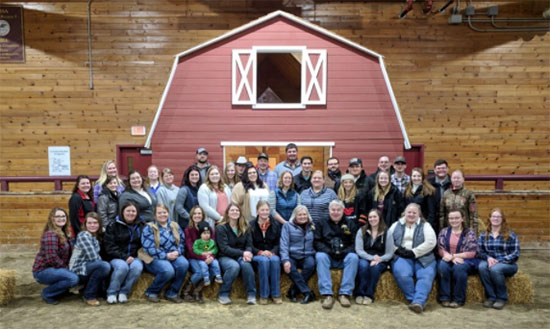

Ag Arama originated in 1975 when Gary McVey, Ph.D., was head of the Agriculture and Natural Resources Division. He was notified of a “margin of excellence program” with a four-day deadline to submit a proposal. The proposal was approved and Truman Tilleraas served as the first advisor. Ag Arama would provide a way for University of Minnesota Crookston (UMC) students to have a fun break while enduring the long Minnesota winters. This would come in the coldest Minnesota month of January. Many accused Ag Arama of causing the cold weather and certainly there were years when a blizzard or extreme cold limited the attendance. Ag Arama included livestock showmanship, crops/horticulture competitions, agriculture business salesmanship, natural resources games, royalty coronation, and a dance. Not all events were incorporated in year one nor were they all completed every year, but the majority of events were included most years.
The earliest record of any award being given at Ag Arama was the “True Grit Award” dedicated to Todd Opsahl, a student in 1973-74. This award was started in dedication to Todd after his fight with leukemia, eventually losing the battle shortly after he left college. It was known he participated in Agriculture and Natural Resources campus activities even during and after treatments that were painful. Todd was a fighter and overcame obstacles to actively participate in the early Ag Arama events. Those who knew Todd felt it was his “True Grit” that allowed him to participate even while in great pain. Hence, the “True Grit” award began in 1976 with Jeff Kratochwill 1977 being the first recipient. This award has been given annually since then with similar traits of resilience, active participation, and overcoming obstacles being important to continue the long tradition of Ag Arama. Throughout history, receiving the “True Grit” award is the most prestigious of any award given.
The early years of Ag Arama were held in the Winter Shows Building located south of the campus. The large arena provided much space for a multitude of events. It later moved to the north arena of the Winter Shows Building and finally to the campus University and Teaching Outreach Center (UTOC). Natural Resources faculty and staff have provided many contests such as tree felling, log splitting/chopping, log peeling, crosscut saw, pole (log) toss, match splitting, tobacco spitting later changed to sunflower seed spitting, and other fun natural resources games to create lively events such as snowshoeing and orienteering for students, alumni, and other community participants.
No awards given during Ag Arama are without great merit. Royalty (king/queen and prince/princess) are not a popularity event as sometimes perceived. It includes a faculty/student nomination, a written essay by the contestant (scored by faculty), an interview before a three-person panel of interviewers, and a vote by fellow students regarding effort put into Ag Arama. In 1987, prince and princess royalty were added. Six animal showmanship awards are now given since the addition of goat showmanship in recent years. Other showmanship include: horse, dairy, sheep, beef, swine, and lamb lead. The addition of novice competition was added by students over ten years ago and brought a dramatic increase in competitors and “expert showpersons'' work with novices to improve their showmanship skills without competing against them. This took most of the intimidation of being a novice away and encouraged everyone to compete on a fair basis. That single decision may be the most important in the later years of Ag Arama. The top show person in each species competes against each other in “round robin '' competition which pits the best against the best with all competitors having to show all six species. The winner of the round robin competition is truly a skilled show person who most people will marvel.
A large group of crops categories are also competed in each year. Similar to the animal competitions, an overall winner is awarded which again takes a very well rounded and talented individual to win. Some individual categories include cereal crops, oil seeds, small seeded legumes, large seeded legumes, grass seed, specialty crops, and forage crops.
Ag Arama has served as a common place for agriculture and natural resources alumni to return and visit with fellow alumni. Alumni showmanship began in later years and provides much fun and many laughs. An alumni social held prior to the dance so alumni can visit and exchange memories. Students and alumni may be tired, but they turn out for the dance that extends late into the evening. Sleep can come on a different day.
Each year the Ag Arama committee dedicates the event to an individual -- commonly a faculty member (often retired). Occasionally, it was given to other supportive community members. It is considered a great privilege to have Ag Arama dedicated to you and is even more meaningful since it is truly a student run organization.
Student leadership has been a hallmark of Ag Arama. Students gain many leadership experiences if they assume such a role in Ag Arama. When UMN Crookston converted from a two-year to a four-year institution, Ag Arama demonstrated the benefits of having students for four years of leadership. Faculty serve a secondary role in this event, with most faculty taking a turn as faculty advisor. It would be remiss not to mention the current advisor, Terrill Bradford, has taken far more years than any other faculty member. Students have come to appreciate her valued and wise council since the early 2000’s. Lab technicians and faculty, along with division chairs, have provided needed support to students, especially when UMC was a two-year institution.
It is always difficult to measure the true worth of any event, but it can be argued Ag Arama provides the environment for developing leaders since it is one of the few university groups where decision making and operations are almost exclusively a result of student effort. The Ag Arama Committee would welcome all alumni to join them at Ag Arama in the coming years.



